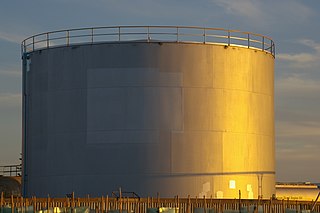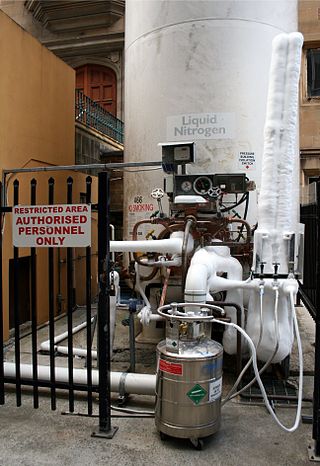Related Research Articles

Distillation, or classical distillation, is the process of separating the components or substances from a liquid mixture by using selective boiling and condensation, usually inside an apparatus known as a still. Dry distillation is the heating of solid materials to produce gaseous products ; this may involve chemical changes such as destructive distillation or cracking. Distillation may result in essentially complete separation, or it may be a partial separation that increases the concentration of selected components; in either case, the process exploits differences in the relative volatility of the mixture's components. In industrial applications, distillation is a unit operation of practically universal importance, but is a physical separation process, not a chemical reaction. An installation used for distillation, especially of distilled beverages, is a distillery. Distillation includes the following applications:

Liquid hydrogen (H2(l)) is the liquid state of the element hydrogen. Hydrogen is found naturally in the molecular H2 form.
Fractional distillation is the separation of a mixture into its component parts, or fractions. Chemical compounds are separated by heating them to a temperature at which one or more fractions of the mixture will vaporize. It uses distillation to fractionate. Generally the component parts have boiling points that differ by less than 25 °C (45 °F) from each other under a pressure of one atmosphere. If the difference in boiling points is greater than 25 °C, a simple distillation is typically used. It is used to refine crude oil.

A gas cylinder is a pressure vessel for storage and containment of gases at above atmospheric pressure. High-pressure gas cylinders are also called bottles. Inside the cylinder the stored contents may be in a state of compressed gas, vapor over liquid, supercritical fluid, or dissolved in a substrate material, depending on the physical characteristics of the contents. A typical gas cylinder design is elongated, standing upright on a flattened bottom end, with the valve and fitting at the top for connecting to the receiving apparatus.

In chemistry, volatility is a material quality which describes how readily a substance vaporizes. At a given temperature and pressure, a substance with high volatility is more likely to exist as a vapour, while a substance with low volatility is more likely to be a liquid or solid. Volatility can also describe the tendency of a vapor to condense into a liquid or solid; less volatile substances will more readily condense from a vapor than highly volatile ones. Differences in volatility can be observed by comparing how fast substances within a group evaporate when exposed to the atmosphere. A highly volatile substance such as rubbing alcohol will quickly evaporate, while a substance with low volatility such as vegetable oil will remain condensed. In general, solids are much less volatile than liquids, but there are some exceptions. Solids that sublimate such as dry ice or iodine can vaporize at a similar rate as some liquids under standard conditions.

A crankcase ventilation system removes unwanted gases from the crankcase of an internal combustion engine. The system usually consists of a tube, a one-way valve and a vacuum source.

An oil terminal is an industrial facility for the storage of oil, petroleum and petrochemical products, and from which these products are transported to end users or other storage facilities. An oil terminal typically has a variety of above or below ground tankage; facilities for inter-tank transfer; pumping facilities; loading gantries for filling road tankers or barges; ship loading/unloading equipment at marine terminals; and pipeline connections.

Vaporrecovery is the process of collecting the vapors of gasoline and other fuels, so that they do not escape into the atmosphere. This is often done at filling stations, to reduce noxious and potentially explosive fumes and pollution.

The AP 42 Compilation of Air Pollutant Emission Factors is a compilation of the US Environmental Protection Agency (EPA)'s emission factor information on air pollution, first published in 1968. As of 2018, the last edition is the 5th from 2010.

Storage tanks are containers that hold liquids, compressed gases or mediums used for the short- or long-term storage of heat or cold. The term can be used for reservoirs, and for manufactured containers. The usage of the word tank for reservoirs is uncommon in American English but is moderately common in British English. In other countries, the term tends to refer only to artificial containers.

An evaporator is a device used to turn a liquid into a gas.
Tank blanketing, also referred to as tank padding, is the process of applying a gas to the empty space in a storage container. The term storage container here refers to any container that is used to store products, regardless of its size. Though tank blanketing is used for a variety of reasons, it typically involves using a buffer gas to protect products inside the storage container. A few of the benefits of blanketing include a longer life of the product in the container, reduced hazards, and longer equipment life cycles.
An onboardrefueling vapor recovery system (ORVR) is a vehicle fuel vapor emission control system that captures volatile organic compounds (VOC, potentially harmful vapors) during refueling. There are two types of vehicle emission control systems: the ORVR, and the Stage II vapor recovery system. Without either of these two systems, fuel vapors trapped inside gas tanks would be released into the atmosphere, each time refueling of the vehicle occurred. However, an ORVR system is able to retain those emissions, delivering them to the vehicle's activated carbon-filled canister and then to dispose of those vapors by adding them to the engine's inlet manifold and the stream of fuel supplying the engine, during normal operation. The goal behind implementing the ORVR system throughout the U.S. is to eventually make the Stage II systems obsolete.
Groundwater remediation is the process that is used to treat polluted groundwater by removing the pollutants or converting them into harmless products. Groundwater is water present below the ground surface that saturates the pore space in the subsurface. Globally, between 25 per cent and 40 per cent of the world's drinking water is drawn from boreholes and dug wells. Groundwater is also used by farmers to irrigate crops and by industries to produce everyday goods. Most groundwater is clean, but groundwater can become polluted, or contaminated as a result of human activities or as a result of natural conditions.
True vapor pressure (TVP) is a common measure of the volatility of petroleum distillate fuels. It is defined as the equilibrium partial pressure exerted by a volatile organic liquid as a function of temperature as determined by the test method ASTM D 2879.

An external floating roof tank is a storage tank commonly used to store large quantities of petroleum products such as crude oil or condensate. It consists of an open- topped cylindrical steel shell equipped with a roof that floats on the surface of the stored liquid. The roof rises and falls with the liquid level in the tank. As opposed to a fixed roof tank there is no vapor space (ullage) in the floating roof tank. In principle, this eliminates tank breathing loss and greatly reduces the evaporative loss of the stored liquid. There is a rim seal system between the tank shell and roof to reduce rim evaporation.

A cryogenic storage dewar is a specialised type of vacuum flask used for storing cryogens, whose boiling points are much lower than room temperature. Cryogenic storage dewars may take several different forms including open buckets, flasks with loose-fitting stoppers and self-pressurising tanks. All dewars have walls constructed from two or more layers, with a high vacuum maintained between the layers. This provides very good thermal insulation between the interior and exterior of the dewar, which reduces the rate at which the contents boil away. Precautions are taken in the design of dewars to safely manage the gas which is released as the liquid slowly boils. The simplest dewars allow the gas to escape either through an open top or past a loose-fitting stopper to prevent the risk of explosion. More sophisticated dewars trap the gas above the liquid, and hold it at high pressure. This increases the boiling point of the liquid, allowing it to be stored for extended periods. Excessive vapour pressure is released automatically through safety valves. The method of decanting liquid from a dewar depends upon its design. Simple dewars may be tilted, to pour liquid from the neck. Self-pressurising designs use the pressure of the gas in the top of the dewar to force the liquid upward through a pipe leading to the neck.
A volatile corrosion inhibitor (VCI) is a material that protects metals from corrosion. Corrosion inhibitors are chemical compounds that can decrease the corrosion rate of a material, typically a metal or an alloy. NACE International Standard TM0208 defines volatile corrosion inhibitor (VCI) as a chemical substance that acts to reduce corrosion by a combination of volatilization from a VCI material, vapor transport in the atmosphere of an enclosed environment, and condensation onto surface in the space, including absorption, dissolution, and hydrophobic effects on metal surfaces, where the rate of corrosion of metal surfaces is thereby inhibited. They also called vapor-phase inhibitors, vapor-phase corrosion inhibitors, and vapor-transported corrosion inhibitors.
Refining of crude oils essentially consists of primary separation processes and secondary conversion processes. The petroleum refining process is the separation of the different hydrocarbons present in crude oil into useful fractions and the conversion of some of the hydrocarbons into products having higher quality performance.

In an oil and gas production, flash-gas is a spontaneous vapor that is produced from the heating or depressurization of the extracted oil mixture during different phases of production. Flash evaporation, or flashing, is the process of volatile components suddenly vaporizing from their liquid state. This often happens during the transportation of petroleum products through pipelines and into vessels, such as when the stream from a common separation unit flows into an on-site atmospheric storage tank. Vessels that are used to intentionally “flash” a mixture of gas and saturated liquids are aptly named "flash drums." A type of vapor-liquid separator. A venting apparatus is used in these vessels to prevent damage due to increasing pressure, extreme cases of this are referred to as boiling liquid expanding vapor explosion (BLEVE).
References
- ↑ BNH Gas Tanks. "Fixed Roof Tank" . Retrieved 5 December 2015.
- 1 2 South Coast Air Quality Management District. "Supplemental Instructions For Liquid Organic Storage Tanks" (PDF). Retrieved 5 December 2015.
- ↑ Werner Sölken. "Explore the World of Piping - Introduction to Storage Tanks" . Retrieved 5 December 2015.
- ↑ USA Environmental Protection Agency. "Alternative Control Techniques Document:Volatile Organic Liquid Storage in Floating and Fixed Roof Tanks" (PDF). Retrieved 5 December 2015.
- ↑ Buckeye Fire Equipment. "Storage Tanks: Fixed or Semi-fixed Systems" (PDF). Retrieved 5 December 2015.
- ↑ ISEC Company. "Fixed Roof Tank".